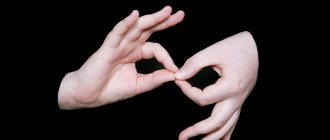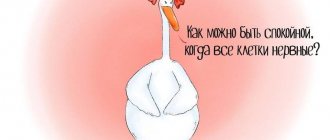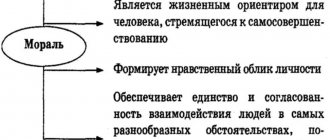What is the essence of the method
Reflection using the five-finger method consists of five stages aimed at different areas of human life:
- Intelligence;
- Achievements of goals;
- Emotions;
- Interaction with other people;
- Health and wellness.
The essence of the method is to assess how the past day or completed task affected each of these areas. To make it easier to remember the stages, the method uses simple mnemonics: each stage corresponds to a different finger on the hand. This is what it looks like:
The five-finger method was proposed by German time management specialist Lothar Seiwert. According to his original plan, this technology was intended to quickly summarize the results of the day. It is designed so that it can be easily used at any free moment: on public transport, while driving a car or while waiting in line.
But it soon became clear that the method proposed by L. Seivert could have wider application. For example:
- Summing up the week, month, year (not just the day).
- Analysis of completed tasks and projects.
- Assessment of the events that occurred.
In addition, it can be used not only for quick mental analysis, but also for thoughtful “debriefing” with paper and pencil.
Let's now see how to use the five finger method in practice.
GuruTest
It is very important to maintain mental hygiene. If you don’t know how to do this, then stress and negativity appear in your life more often. Along with the five finger technique, learn this simple hygiene. It's like washing your hands, only spiritually.
Introduction to Five Finger Technique
Any negative memories make themselves felt with some frequency. Fears, worries and stress prevent us from doing what we love and what we want. The longer we are “trained” by a past trauma or some kind of psychological problem, the more difficult it is to get rid of it.
The five finger technique is based on mnemonics. The fingers symbolize something specific, so it will be easier for you to remember this technique so as not to constantly remind yourself of it while rereading the article over and over again. This is a very simple method that has proven to be very effective, but is relatively unknown, so you may never have heard of it.
This technique is based on stopping the influence of an external problem by transferring control to yourself. To move closer to independence, you need to take matters into your own hands. It is necessary to interrupt an unpleasant situation.
How does this technique work?
It's a fairly simple technique, as the scientist who invented it named Richard Grannon sought to create something that children could understand while working in schools. You must use the equipment five times a day for 30 days. Considering that the technique is very simple, you will need less than five minutes a day to clear your mind of negative memories, thoughts, and anxiety.
There are five affirmations in total that remind you of your goals. The main goal is composure, freedom, positivity. Formulate your goal to which you will strive. Five toes five times a day will help you move toward emotional healing and balance.
First finger. Tap the thumb, which symbolizes yourself, because it is the thickest and most important of all. Repeat to yourself: “I am me. I am not my fears, not my problems, not my negative memories.” It doesn't seem to help, but it doesn't. With these words, you create emptiness, a gap between negative memories and your reaction to them. You can replace the vague phrase with a clearer one: “I am not work problems, not divorce, not money problems, not anxiety, not anger, not sadness, and so on.” The main thing is to repeat the same thing. The first step tells you that it doesn't matter how bad things are. It is important to accept the current situation.
Second finger. It reminds you of your goal. This is the index finger that is always pointing at something. It shows you what you are aiming for. Say while tapping your index finger: “I am moving towards the target state. I become more emotionally stable, kinder, calmer, and so on.” This is just an example, because here it is also important to formulate everything in accordance with your goals.
Third finger. The middle finger is wisdom. It reminds you of the importance of opening the door to your feelings with warmth. Richard Grannon also calls it the finger of welcome, because it welcomes and lets in positive emotions. This finger is the longest, so it is important to think of it as an antenna that receives a positive signal. While tapping on it, repeat: “I accept what I feel: sadness, anger, weakness, etc.” If you don’t accept the negative emotions that come to you, you can stop feeling the good things.
Fourth finger . The ring finger is an egoist. It reminds us that it is important to put yourself first. It reminds you of what is needed for you. It helps lift the weight off our shoulders that weighs on us every day. Repeat to yourself while holding this finger: “I will only do what is necessary for me. This is important for me, for my purification.”
Fifth finger. The little finger symbolizes separation. It separates everything extraneous from ourselves. Repeat to yourself while holding your little finger: “Only I am in control of myself. This is my body, my destiny, my life, my time.” Your right to own you is granted by nature itself, by God, by law - at your discretion.
Here’s a quick version of what you need to say: “I am not my problems, negativity and stress. I see a goal and go towards it (we pronounce the goal). I accept what I feel. I will do what I need to do. I am in control."
Remind yourself of this five times a day. Say what the scientist recommends. You will see how your life and attitude towards it will change after 30 days. Then you can change your goals and work on other problems. It is important to experience negative emotions, accepting them in the same way as positive ones. It is important to remember that you are the center of the universe to yourself.
Our Yandex.Zen channel always has the most interesting articles on this topic. Be sure to subscribe!
17.03.2020 01:27
Analysis of the completed task
To analyze completed projects and tasks, virtually the same algorithm is used as for summing up the results of the day.
1. Little finger (thoughts). Summarize your experience. What did you learn after completing the task? What new techniques did you use? What ideas did you come up with?
Examples:
| Morning running | 1. You need to maintain a constant breathing rhythm: this makes it easier to run. 2. It’s better not to run through the old park, because there are a lot of dog walkers there. |
| Order in the wardrobe | I organized my underwear and socks according to Marie Kondo’s method: two drawers were freed up at once. |
| Creating a corporate blog | 1. Self-written engines are inconvenient, buggy and expensive. 2. The best articles are obtained when the author and an expert from the company work together. 3. An inexhaustible source of blog topics is customer questions and problems. |
2. Unnamed (proximity of target). How did the task help you achieve your goals? How has she influenced your life?
Examples:
| Morning running | I feel energetic all day (goal: to improve my well-being). |
| Order in the wardrobe | This was the most difficult stage of spring cleaning. |
| Creating a corporate blog | In the first two weeks of blog operation, the number of visitors to our online store increased by 20%. |
3. Average (condition). How do you feel after completing a task? Are you satisfied with the result?
Examples:
| Morning running | Despite being slightly tired, my mood improved. The head began to work better. |
| Order in the wardrobe | I feel like a pro at folding clothes. I would like to “bring to mind” the whole apartment in the same way. |
| Creating a corporate blog | Satisfied with the work and the result. I regret that I listened to all sorts of “smart guys” and didn’t start a blog six months ago. |
4. Index (services). Evaluate your interactions with other people (if any). How did completing the task affect your relationship with them? Who else has benefited from this challenge?
Examples:
| Morning running | |
| Order in the wardrobe | |
| Creating a corporate blog | 1. We need a chief editor who will work with freelancers (I don’t have enough patience). 2. It was difficult to persuade my partner not to fill the blog with advertising and company news. |
5. Big (cheerfulness). How difficult was the task? Why? How has your physical condition changed?
Examples:
| Morning running | I have more energy: I accomplished everything I planned today. |
| Order in the wardrobe | While I was putting things in order, I listened to pleasant music and actually didn’t get tired. |
| Creating a corporate blog | The most difficult thing was to negotiate, explain and monitor implementation. I wasn’t physically tired, but I was nervous at times. |
Sometimes it happens that on some points nothing comes to mind. For example, your task did not involve any communication with people. Or, let's say you can't remember what your physical and emotional state was like while performing a task. This means that this stage of analysis does not contain significant information and can be safely skipped.
Ideal participant
So, we already have the goal of our project - a super task that the team is trying with all its might to bring to life. And here the main question arises - what actions should we take so that at the end of the project our participants understand what we wanted to convey to them? In our opinion, the next step is to understand for ourselves what an “ideal participant” should be. An “ideal participant” is a participant who has fully accomplished all of our project goals. At the same time, the more detailed we describe what our “ideal participant” should know, be able to and feel, the better we will understand which path we need to take him along.
This is what it might look like:
- The participant knows in what year the Battle of Borodino took place.
- The participant joined the “History of Europe” group on the social network “Vkontakte”.
- A participant turns the TV up louder when he hears on the news about new discoveries in the field of nanotechnology.
- The participant began reading the book “Counselors’ Manual.”
- The participant can distinguish between the “hippie” and “emo” subcultures.
- The participant added music they heard on your project to their playlist.
- The participant knows the principles of your organization and considers himself a part of it.
Sometimes a detailed description of the participant “before the project”, that is, who has not yet gone through the process with us, can help to imagine the ideal participant “after the project”. Questions can also help: “What should NOT be the ideal participant?” or “What will the participant do with the experience gained after the end of the project?”
Presenter Tools
Our project is almost ready. To complete it, we only need one thing - to select suitable methods, forms and “tricks” that will help us reveal the selected topics and decorate our project. We call these tools.
Here are some examples of tools to better understand what we include in this concept:
- discussion,
- dilemmas with/without answer options,
- lecture,
- working with texts,
- atmospheric design of the room,
- calm or, conversely, rhythmic music,
- gifts for all camp participants,
- maintaining an Internet resource during and after the project,
- photo and video reports on the work done.
We will not compile a list of all the tools that can be used - there are a lot of interesting finds described on the Internet and in various literature.
For the presenter, this is perhaps the most creative and interesting stage of writing a project. However, it happens that the chosen tool is not chosen accurately and significantly changes the emphasis in the topic raised. Often, having played with the choice of tools, the presenter loses what we use this or that tool for. In most cases, this is due to the fact that the presenter first selects a tool, and then adjusts the rest of the project to it.
In order for these tools to work correctly, that is, to fulfill their purpose, we advise you to first go through the entire preparatory process, that is, go through all the points of the scheme from the very beginning, and only at the last stage proceed to the selection of forms and methods. In our opinion, if the presenter clearly understands what he wants to achieve from raising this topic, then selecting a suitable tool will be much easier.
To illustrate the path from writing the goal to the tools, you can use a ladder leading from the “problem” to the “ideal participant.” Moreover, each stage is a selected topic, for each of which, in turn, a suitable tool is selected.
Example from life:
The facilitator wants to get feedback from the participants about the project and set the goal of this event to “Collect constructive feedback.” At the same time, he creates a romantic atmosphere in the room - dim lights, candles, calm music, and begins a conversation with the group in a half-whisper. Can we expect constructive criticism in this environment? All these tools will most likely contribute to the fact that the participant will feel awkward in a given atmosphere to talk about points that he did not like and that he would like to change. However, it cannot be said that this event will be unsuccessful. Not at all, it will be successful and, most likely, the participants will really like it. It will simply fulfill a different goal - “unity and unification of participants.” To achieve this goal, you can use a tool that gives participants a framework within which they will express their opinions about the project. For example, such a tool could be a questionnaire with a carefully thought-out list of questions.
It is difficult to formulate simple and understandable criteria and understand whether the chosen tool is suitable. For this there is personal experience and collective discussion of the presenters. In any case, it is advisable for every presenter to have a wide variety of tools at his disposal so that he has plenty to choose from. We leave this to each of you. The Internet, literature and creativity are the best helpers in this. Use known and proven ones, come up with new ones, experiment, create tools - it’s incredibly interesting!
I'm creating
Talk about this every time you start any creative endeavor. Here it is worth clarifying that a creative endeavor is one that is aimed at producing some unique result (although the scale of this endeavor is not at all important).
I create order. For example, when you are cleaning, checking your plans, or raising a child.
I create the result. When you balance debits with credits, draw a bridge plan or look for suppliers.
I create success. When you overcome any difficulty in your path.
I create opportunities. When you lay the foundation for success in the future with your current behavior.
I create relationships. When you are negotiating, advising someone, or getting to know someone.
It is convenient to launch the body memory with this gesture:
How it works?
To cope with the task, you need to introduce associations. For example, like this:
1. Large - a lot, increase 2. Index - show, point, point with a finger 3. Medium - stick out, put your hand forward, send everything 4. Nameless - no one knows why this happened, there was a name! 5. Little finger - small, decreasing
Here. And now we take any question and begin: we increase the problem beyond recognition, now it is not a local problem, it is a problem of the entire planet. Global. It is so huge that individual elements appeared on it. Point your finger at the worst of them. Now stick out your middle finger and point your hand towards the terrible element.
- Fuck you! - suddenly burst out of you?
Now look at the ring finger, think why its name is lost? Do it with a terrible element. Lose it, forget the name. It does not exist. Now reduce the problem to its original state. And now this is no longer a problem...
C (middle): State of mind
Ask yourself this. What was my mood during the day? How did it change? What did this depend on? Is the world a good place? Or beautiful? How to make it like this?
If in the list of emotions such as “nothing special”, “so-so”, “everything is enough”, “bad”, “tired of everything” come up, then these are alarm bells! The next day, set yourself a goal to be more attentive to your inner, mental state: for example, every half hour, mark your mood for yourself - for example, with emoticons in a notepad.
Important addition
The described five-finger method serves as a kind of litmus with which you can find your weaknesses, determine what still needs to be worked on, and what to achieve in your self-development. And the best tools for this are provided by Vikium courses. Thus, “Brain Detoxification” will help you understand and manage your own emotions, sleep better and reduce stress levels. And the “Course on Goal Setting” will bring your aspirations, desires and aspirations into a coherent system: you will be able to accomplish more in the same time, live more productively and happier!











